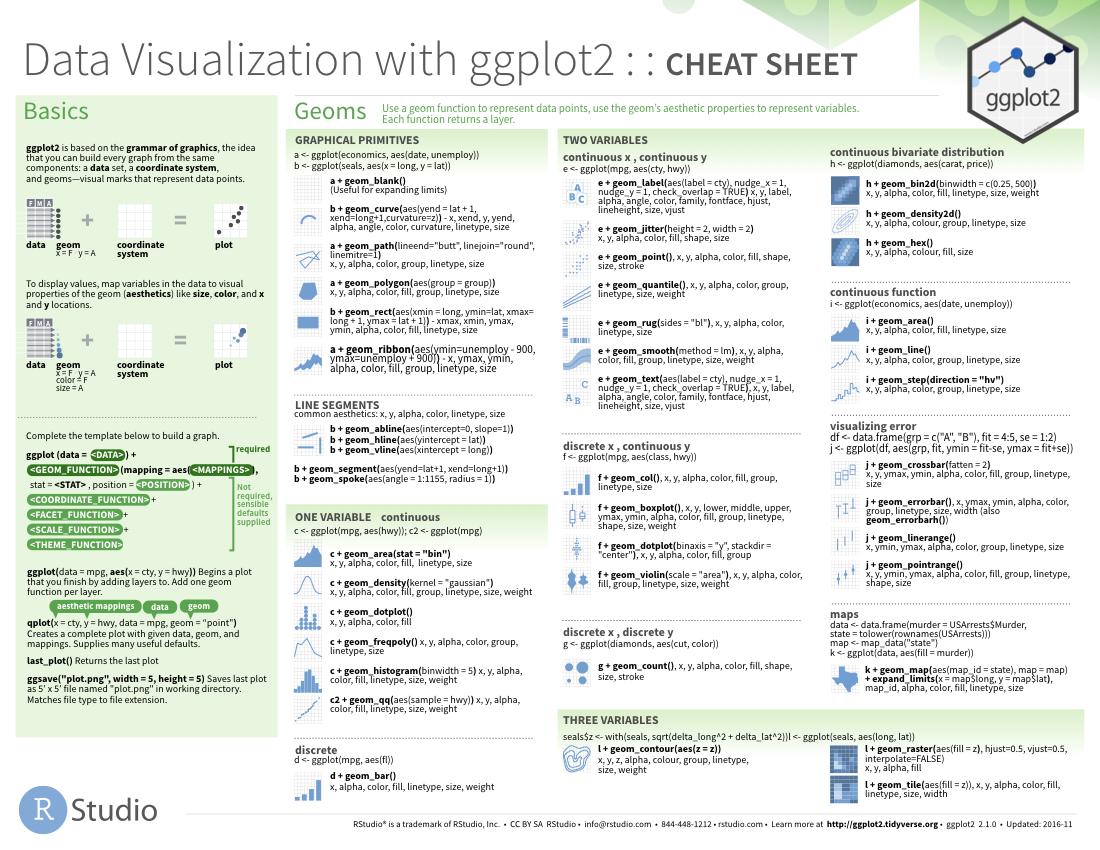If you spend time with R regularly then you should have the basics of data manipulation & plotting down within a couple of weeks. The more esoteric functions will take time to master. These are PDF cheat sheets that can be printed out. Keep them handy as you work with R.
help.start() - This first link doesn't actually take you to another site because it isn't a resource on the web, it's contained with R. To access it just type help.start() at the prompt and a collection of manuals will appear in your browser window. Pretty handy reference tool, eh?
R cheat sheet 1. Basics Commands objects List of objects in workspace. Values of x to code. Use if some values are not present in data, or if the order would be wrong. Labels = c Values associated with factor levels exclude = c Values to exclude. Essential Statistics with R: Cheat Sheet Important libraries to load If you don’t have a particular package installed already: install.packages(Tmisc).
R Reference Card - This is the most popular reference card. This same document is available from a number of sites and includes info on input & output, getting help, working with variables & arrays, plotting & more. You want this one.
R for Data Mining - This document was written by RDataMining.com. It includes info on classification, clustering, social network analysis, big data and more. This is very handy if you're interested in knowledge discovery & data mining.
R Style Guide - This resource is more than a cheat sheet. Google's internal R user community put together this guide for clean R code that covers syntax & conventions that are unique to R. I include it here because I've refered to it quite a bit in my own work. Your code will be easy to read & maintain if you follow these guidelines.
I reproduce some of the plots from Rstudio’s ggplot2 cheat sheet using Base R graphics. I didn’t try to pretty up these plots, but you should.
I use this dataset
The main functions that I generally use for plotting are

- Plotting Functions
plot: Makes scatterplots, line plots, among other plots.lines: Adds lines to an already-made plot.par: Change plotting options.hist: Makes a histogram.boxplot: Makes a boxplot.text: Adds text to an already-made plot.legend: Adds a legend to an already-made plot.mosaicplot: Makes a mosaic plot.barplot: Makes a bar plot.jitter: Adds a small value to data (so points don’t overlap on a plot).rug: Adds a rugplot to an already-made plot.polygon: Adds a shape to an already-made plot.points: Adds a scatterplot to an already-made plot.mtext: Adds text on the edges of an already-made plot.
- Sometimes needed to transform data (or make new data) to make appropriate plots:
table: Builds frequency and two-way tables.density: Calculates the density.loess: Calculates a smooth line.predict: Predicts new values based on a model.
All of the plotting functions have arguments that control the way the plot looks. You should read about these arguments. In particular, read carefully the help page ?plot.default. Useful ones are:
main: This controls the title.xlab,ylab: These control the x and y axis labels.col: This will control the color of the lines/points/areas.cex: This will control the size of points.pch: The type of point (circle, dot, triangle, etc…)lwd: Line width.lty: Line type (solid, dashed, dotted, etc…).
Discrete
Barplot
Basic R Commands Cheat Sheet
Different type of bar plot Switcher punto for mac.
Continuous X, Continuous Y

Scatterplot
Jitter points to account for overlaying points.

Add a rug plot
Add a Loess Smoother
Loess smoother with upper and lower 95% confidence bands
Loess smoother with upper and lower 95% confidence bands and that fancy shading from ggplot2.
Add text to a plot
Discrete X, Discrete Y
Codecademy R Cheat Sheet
Mosaic Plot
Color code a scatterplot by a categorical variable and add a legend.
par sets the graphics options, where mfrow All shortcuts for mac. is the parameter controling the facets.
The first line sets the new options and saves the old options in the list old_options. The last line reinstates the old options.

Nokia pc suite for mac os. This R Markdown site was created with workflowr
